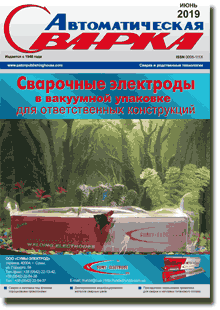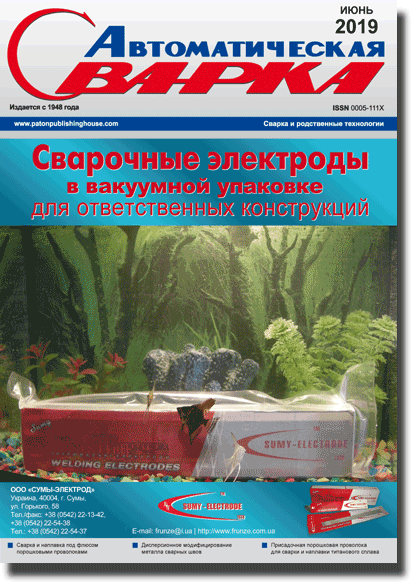| 2019 №06 (06) |
DOI of Article 10.15407/as2019.06.07 |
2019 №06 (08) |

Avtomaticheskaya Svarka (Automatic Welding), #6, 2019, pp.44-50
Effect of temperature on hardness and wear resistance of high-chromium cast irons deposited with flux-cored strips
A.P. Voronchuk, A.P. Zhudra, A.V. Petrov, V.O. Kochura
E.O. Paton Electric Welding Institute of the NAS of Ukraine. 11 Kazimir Malevich Str., 03150, Kyiv, Ukraine. E-mail: office@paton.kiev.ua
The paper presents the procedure and results of investigation of hot hardness of deposited high-chromium cast irons with different level of alloying of 450Kh30M, 500Kh22B7, 500Kh22B7M7V2F, 300Kh25S3N2G2 type as well as 500Kh40NS2GRTs nickel-carbide-chromium alloy. It is determined that hot hardness of deposited metal to significant extent depends on presence and types of carbides in metal structure. With relatively low-alloy high-chromium cast irons the hardness drops at rise of temperature and increases at chromium content up to 30% and carbon to 5%. Alloys doped with chromium, niobium, molybdenum, tungsten and vanadium keep high hardness up to 650 °C temperature. Niobium is important for indicated alloys. It plays a role of modifier delaying growth of primary chromium carbides and forming solid cubic niobium carbide. Nickel-carbide-chromium alloy preserves high hardness up to 650 °C temperature due to presence of high concentration of higher chromium carbides in a nickel-based matrix. Wear resistance of deposited alloys drops with rise of temperature in accordance with drop of deposited metal hardness. 12 Ref., 3 Tabl., 3 Fig.
Keywords: hot hardness, flux-cored strips, surfacing, high-chromium cast irons, nickel-carbide-chromium alloy, wear resistance
Received: 12.04.2019
Published: 20.05.2019
References
1. (1978) Welding in machine-building: Refer. book, 4 Vol. Ed. by A.I. Akulov. Moscow, Mashinostroenie, Vol. 2 [in Russian].2. Zhudra, A.P., Voronchuk, A.P. (2012) Cladding flux-cored strips (Review). The Paton Welding J., 1, 34-38.
3. Ryabtsev, I.A., Senchenkov, I.K., Turyk, E.V. (2015) Surfacing, materials, technologies, mathematical modeling. Wydawnictwo politechniki slaskiej, Gliwice, 362-365, 398-406 [in Polish].
4. Aleksyuk, M.M., Borisenko, V.A., Krashchenko, V.P. (1980) Mechanical tests at high temperatures. Kiev, Naukova Dumka [in Russian].
5. Borisenko, V.O., Oksametnaya, O.B. (1994) DSTU 2434-94: Calculations and strength tests. Method of determination of high-temperature hardness by indentation of pyramidal and bicylindrical indentor. Kiev, Gosstandart Ukrainy [in Russian].
6. Borisenko, V.A. (1975) General regularities in change of mechanical properties of refractory materials depending on temperature. Information 1. Problemy Prochnosti, 8, 58-63 [in Russian]. https://doi.org/10.1007/BF01522400
7. Rumshinsky, L.Z. (1971) Mathematical processing of results of experiment. Moscow, Nauka [in Russian].
8. Khansen, M., Anderko, K. (1962) Structures of binary alloys. Vol. 1, 2. Moscow, Metallurgizdat [in Russian].
9. Ivanko, A.A. (1968) Hardness. Kiev, Naukova Dumka [in Russian].
10. Gallo, C., Hubert, M. (1980) Soudage et Techniques Connexes, 34(11, 12), 371-386.
11. Schramm, H. (1984) Chrom-Niob-legierte Hartlegierungen fuer das Auftragschweissen. Ind.-Anz., 86, 75 [in German].
12. Zhudra, A.P. (2014) Investigation of wear resistance of composite alloys under the conditions of gas-abrasive wear at elevated temperatures. The Paton Welding J., 11, 28-31. https://doi.org/10.15407/tpwj2014.11.05
The cost of subscription/purchase order journals or individual articles
| Journal/Currency | Annual Set | 1 issue printed |
1 issue |
one article |
| TPWJ/USD | 384 $ | 32 $ | 26 $ | 13 $ |
| TPWJ/EUR | 348 € | 29 € | 24 € | 12 € |
| TPWJ/UAH | 7200 UAH | 600 UAH | 600 UAH | 280 UAH |
| AS/UAH | 1800 UAH | 300 UAH | 300 UAH | 150 UAH |
| AS/USD | 192 $ | 32 $ | 26 $ | 13 $ |
| AS/EUR | 180 € | 30 € | 25 € | 12 € |
| SEM/UAH | 1200 UAH | 300 UAH | 300 UAH | 150 UAH |
| SEM/USD | 128 $ | 32 $ | 26 $ | 13 $ |
| SEM/EUR | 120 € | 30 € | 25 € | 12 € |
| TDNK/UAH | 1200 UAH | 300 UAH | 300 UAH | 150 UAH |
| TDNK/USD | 128 $ | 32 $ | 26 $ | 13 $ |
| TDNK/EUR | 120 € | 30 € | 25 € | 15 € |
AS = «Automatic Welding» - 6 issues per year;
TPWJ = «PATON WELDING JOURNAL» - 12 issues per year;
SEM = «Electrometallurgy Today» - 4 issues per year;
TDNK = «Technical Diagnostics and Non-Destructive Testing» - 4 issues per year.





